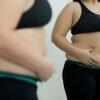Blood normally flows along arteries to the feet and returns through veins back up the leg to the heart. Contraction of the leg muscles helps to pump the blood upwards to the heart, even when we are standing, and the veins contain one-way valves that prevent the blood flowing backwards down the leg. Varicose veins (swollen and painful veins) is a vascular disorder which occurs in the leg when this system breaks down and allows blood to pool in the leg veins instead of being pumped back up the body.
Obesity and Other Risk Factors For Varicose Veins
Obesity is a risk factor for varicose veins as excess fat increases pressure on the vascular system in the legs. Inherited weakness of the valves in the veins and female hormonal problems (and pregnancy) are other risk factors. Occupations that involve standing for long periods with little walking can also increase the risk of varicose veins.
Reducing Varicose Veins
Weight reduction helps to ease varicose veins. Many people see a dramatic improvement after losing as little as 10-14 pounds. Exercise is also a big help for anyone suffering from varicose veins – or other circulatory problems. It helps to pump blood around the body and maintain good circulation. In chronic cases of varicose veins, injection therapy or vascular surgery to remove or divide varicose veins, may be necessary.
More About Severe Overweight
Causes of Obesity
Obesity Treatment Methods
Treatment of Morbidly Obese Patients
Obesity in Children
Abdominal Obesity Guide
Mild Obesity Guide
Morbid Obesity Guide
Malignant Obesity Guide
Super Obesity Guide





